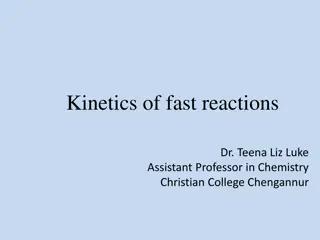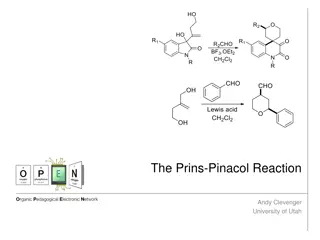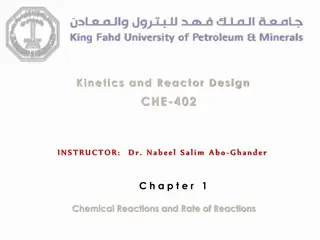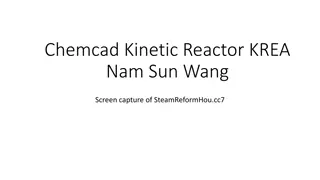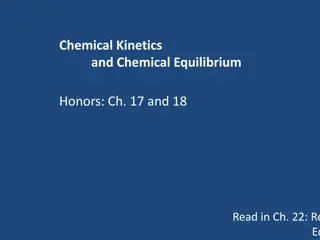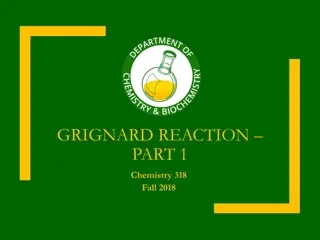Understanding Kinetics and Reaction Rates in Chemistry
Kinetics is the study of reaction rates and factors affecting them, such as concentration, temperature, catalysts, and more. Orders of reaction classify reactions based on rate dependency on reactant concentration. Factors like pH, light, and solvents can also impact reaction rates. Half-life and shelf life are crucial in determining the stability and degradation of products over time. Zero-order reactions have a constant rate independent of reactant concentration.
Download Presentation

Please find below an Image/Link to download the presentation.
The content on the website is provided AS IS for your information and personal use only. It may not be sold, licensed, or shared on other websites without obtaining consent from the author. Download presentation by click this link. If you encounter any issues during the download, it is possible that the publisher has removed the file from their server.
E N D
Presentation Transcript
KINETIC this lab is used to demonstrate the way at which this lab is used to demonstrate the way at which the break down of the product the break down of the product occurs at temperature. temperature. which is used to forecast the rate at which is used to forecast the rate at witch witch activity deteriorates at activity deteriorates at temperature of storage & thus to estimate the shelf life of the storage & thus to estimate the shelf life of the product product . . occurs at elevated elevated temperature of
IMPORTANT DEFINITIONS IMPORTANT DEFINITIONS *kinetics: kinetics:- - is the studying of reaction rate & factors affecting it. *Reaction rate: Reaction rate:- - is the velocity or the speed at which the reaction proceed ,it is given by dc/dt ,this expression gives + the increase or the decrease of concentration dC within a given time interval dt. *Reaction order: Reaction order:- - is the number of atoms or molecules whose concentration determine the reaction rate . the reaction order shows the way of how the concentration Of reactant affecting the reaction rate.
FACTORS THAT MAY AFFECTING REACTION RATE: 1 1- - concentartion concentartion of reactant of reactant 6 6- -pH pH 2 2- -temperature temperature 5 5- -light light 3 3- -catalysts catalysts 4 4- -presence of presence of solvents solvents
*ORDERS OF REACTION: A-zero order reaction:- the rate of reaction is independent on reactant conc. So , -dc/dt=k B-first order reaction:- A B+C So - dc/dt=k[A] C-second order reaction:- A+B C+D So -dc/dt=k[A][B] D-third order reaction:- 2A+B C+2D So, -c/dt=k[A] [B]
*half life t half life t 1 1/ /2 2% : time required for the drug to decompose to one half its original concentration . % :- - is the *shelf life t shelf life t 90 required for the drug to lose10% of it's original concentration .Or it s the time required for the drug to degrade to 90% of it's original concentration. 90%: %:- - is the time
A-ZERO ORDER REACTION:- since the rate is independent on the concentration of the reactant So - dc/dt=k k :zero order rate constant (conc./time or mole.liter .s ) dc= -k dt ???? = -k ? ??? ?? ct - c = -kt ct =c - kt for t 50% 0.5c =c - k t 50% 0.5c = k t 50% t 50%=c /2 k For t 90% 0.9c = c - k t 90% 0.1c = k t 90% t 90% =c / 10 k
B-FIRST ORDER REACTION :- Reaction Reaction rate depend on rate depend on the - -dc/ dc/dt dt c c b by integration y integration the 1 1st power of the concentration of single reactant. st power of the concentration of single reactant. k k = =1 1st st order order rate constant ( rate constant (1 1/time /time or or mi min n ) ) ? ?? ??? ? lnc lnc - - lnc lnc lnc - - lnc after rearrangement after rearrangement logc logc = = logc logc - - kt ? = ? ? lnc = = - -k (t lnc = = - -kt k (t- -0 0) ) kt logc logc - - logc logc = = - -kt kt/ /2.303 2.303 kt/ /2.303 2.303
* * to calculate t to calculate t 50 50% % Log 0.5c = log c - kt 50%/2.303 Kt 50% /2.303 =logc - log0.5c Kt 50% / 2.303= log c /0.5c kt 50% /2.303=log2 t50% = 0.693/ k *To calculate t 90% Log 0.9c = logc -kt /2.303 Kt/2.303 =log c /0.9c t 90% = 0.105 /k
FIRST ORDER NOTE both t both t50 concentration Independent , concentration Independent , thus for t thus for t50 50% it takes the % it takes the same amount of time to same amount of time to reduce the concentration of reduce the concentration of drug from drug from 100 100mM to mM to 50 as it does from as it does from 50 mM. mM. 50% & t % & t90 90% are % are 50 mM mM mM to to 25 50 mM 25
TEMPERATURE *in addition to the concentration of the reactant temperature can also increase the reaction rate as expressed in Arrhenius equation :- K = ?? ??/?? K :-specific reaction rate constant A :- constant known as frequency factor or arrhenius factor Ea :- energy of activation R :- molar gas constant(1.987 cal /degree.mole) T :- absolute temp.(T =273+ C )
lnK = lnA Ea/RT 2.303 log K = 2.303 log A Ea/RT LogK = logA -Ea / 2.303 RT
NOTES : Note:-the constants A & Ea are obtained by determining k at several temperature & then plotting log k versus 1/T. The slope of the resulting line equals Ea/2.303R.the intercept on the vertical axis equals log A. Note:-activation energy (Ea) is the amount of energy required to put the molecules in an activated state. molecules must be activated to react & as the temperature increases more molecules are activated & the reaction rate increase. Note:-according to accelerated storage test k value for the hydrolysis of aspirin at various elevated temperature (40,55& 70 c ) are obtained by plotting log concentration versus time. Then log k are plotted against the reciprocal of absolute temperature & the resulting line is extrapolated to room temperature
the plot known as Arrhenius plot for predicting stability at room temperature. Note:-Arrhenius found that speed of many reactions increase about 2 or 3 time with each 10c rise in temperature . So we can apply Arrhenius equation to find the reaction rate at temperature of storage.
Aim of experiment:- studying the effect of temperature on the hydrolysis of aspirin (1st order kinetic) in order to use it as guide to estimate t50%,t90% Materials & equipment:- aspirin, trisodium citrate, NaOH phenol red indicator ,N/20 NaOH solu. conical flask(250cc)&conical flask(150,50 cc),pipette& burette three water baths.
PROCEDURE:- 1-prepare the following mixture in 250ml conical flask : aspirin 4.5 gm trisodium citrate 9gm D.W. to 250ml 2-take 10ml from solution & titrate with N/20 NaOH solution. Using phenol red as indicator the end point is changing from yellow to pink .This End point.at zero time is represented by X which is the volume of NaOH equivalent to aspirin before hydrolysis . 3-label 3 flasks with the experimental temp. 40,55,70 c & place about 80 ml of mixture in each. 4-note the time & place the flask for the elevated temperature in water bath provided. 5-take 10ml sample from each flask every 15 min. for one hour titrate the sample with N/20 NaOH solution. 6-find the end point of each temperature at the time interval mentioned & represent item Y1,Y2,Y3,Y4 mL of N/20 NaOH.
CALCULATION CALCULATION 1- the initial titration figure of Xml N/20 NaOH will represent 100% potency & when aspirin is completely hydrolyzed to S.A.& acetic acid it required 2X ml N/20 NaOH . Thus the amount of aspirin remaining after partial hydrolysis would be equivalent ( 2X-Y) ml N/20 NaOH where Y is the titration figure for partially hydrolyzed sample . Thus percent potency is given by :- Potency % =c%= ( 2X-Y/X) 100 .percent of remaining aspirin 2-take log c% & plotted against time (min) for each temperature. 3-find the rate constant K for each temperature from the slope of the line . K= - slope 2.303 4-take log K& plot against reciprocal tempreture ( 1/T) ( Arrhenius plot ) to find K at 25 c ,t50%,t90% . 5- tabulate the result as follows :
Table 1 temp. Time ml NaOH c% logc% Table 2 Temp.(c ) T 1/T K logK









